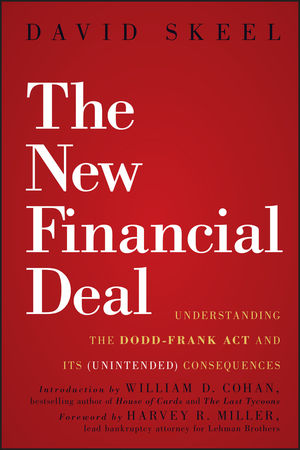The New Financial Deal: Understanding the Dodd-Frank Act and Its (Unintended) ConsequencesISBN: 978-0-470-94275-8
Hardcover
240 pages
December 2010
 This is a Print-on-Demand title. It will be printed specifically to fill your order. Please allow an additional 10-15 days delivery time. The book is not returnable.
|
||||||
Connect with Wiley Publicity
"While we wait and wonder what the true denouement of the Dodd-Frank Act will be, we are blessed with Professor David Skeel's timely, informative, and lucid explanation of the ins and outs of the new law. For readers trying to understand what Dodd-Frank will likely mean for Wall Street's future—and for ours—Skeel skillfully dissects the Act's nuances and intricacies and provides regulators a road map for how to make sure Wall Street doesn't double-cross us again anytime soon. It's a must-read."
—From the Introduction by William D. Cohan, bestselling author of House of Cards, The Last Tycoons and a book on Goldman Sachs to be published in 2011
What would have happened if the government hadn’t bailed out some of the country’s largest and most well-established institutions, such as Bear Stearns, AIG, Citigroup, and Bank of America, in 2008? When President Obama signed the new Dodd-Frank Wall Street Reform and Consumer Protection Act last July, he proclaimed that bailouts like these would never be necessary again. Is this true? And what exactly does the new legislation do?
In The New Financial Deal: Understanding the Dodd-Frank Act and Its (Unintended) Consequences (WILEY; Hardcover; December 2010; $34.95; 978-0-470-94275-8), author, David Skeel offers answers to all of these questions and more. Skeel analyses each of the main components of the Dodd-Frank Act, explaining how they will work and showing that the new regulatory framework depends on precisely the qualities that Americans found so offensive about the bailouts of 2008: special treatment of the largest financial institutions and ad hoc intervention in the event of trouble.
Skeel’s assessment is not entirely pessimistic, however. He argues that a few features of the Dodd-Frank Act are genuine improvements, such as its regulation of financial derivatives and the new Consumer Financial Protection Bureau, and he outlines several simple bankruptcy reforms that would curb the worst excesses of the new partnership between the government and the largest financial institutions. Skeel also considers the international implications of the new law, concluding that its principal contribution to cross-border issues is a requirement that the largest financial institutions prepare “living wills” detailing how they would limit damage to the global financial system if they failed.



